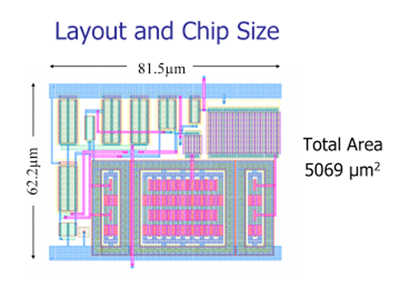EECS 413: Monolithic Amplifier Circuits
Coverage
This course is an introduction to CMOS analog and mixed signal design, but also introduces advanced topics. The course begins with a review of MOS transistors basics, and small signal analysis. Single stage and differential amplifiers are described. CMOS opamps, stability, and frequency compensation are covered. Advanced topics such a switched capacitor circuits may also be covered, time permitting. This course includes a major design project. Students work with a commercial 0.13µm CMOS process. A full suite of commercial design tools from Cadence is used for schematic entry, simulation and layout. (The tools and process technology are close to the state-of-the-art for analog design). Students will have the opportunity to send the best design projects to be fabricated through the MOSIS IC prototyping service (www.mosis.org) Taken alone this course is a good foundation in analog / mixed-signal design. This course is a prerequisite for EECS 511 (analog to digital converters and interfaces) EECS 522 (analog and RF circuits). It also satisfies course requirements of the Circuits and Microsystems, VLSI and E&M majors.
Lab
Labs to learn Cadence schematic entry, simulation, layout and DRC, LVS.
Additional Information
Mini Project Assigned end week 1 October Individual design project. Examples: (1) design and layout of a comparator (2) design and layout of a trans-impedance amplifier Deliverables: schematic, layout and report Main Project Group project assigned before mid-tern Groups of 3 students Formal presentation last day of class. $1,000 prize for best group project, sponsored by industry (e.g. Analog De Group project, teams of 3 Second half of term.


Textbook(s)
Razavi, Behzad. Design of Analog CMOS Integrated Circuits. New York: Mcgraw Hill Higher Education, 2003.
Syllabus
- Introduction
- Chapter 1 Applications and research
- Chapter 2 MOS Devices, small signal model, Bipolar transistors
- Chapter 3 Single stage amplifiers: loads, common source, common drain, common gate, cascade folded cascade
- Chapter 4 Frequency response: poles, zeros, Miller theorem, frequency analysis of single stage amplifiers
- Chapter 5 Differential amplifiers: differential pair large signal and small signal behavior, common mode and differential mode, loads, frequency response
- Chapter 6 Current Mirrors and active loads, low voltage cascades, CMFB, CMRR
- Chapter 7 Feedback: benefits of feedback, feedback configurations
- Chapter 8 Stability and compensation
- Chapter 9 More about opamps: advanced opamaps, other opamp specs
- Other topics, e.g. Switched capacitor circuits
 MENU
MENU 
